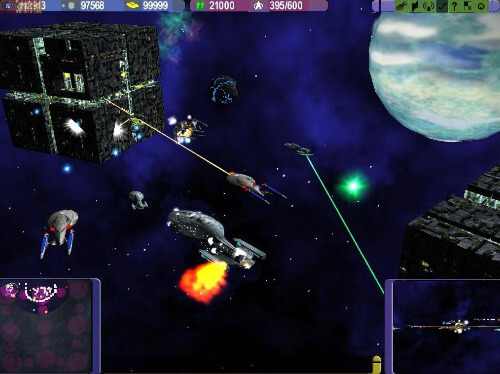Tactics and play as far as solo gaming go are then best left on the easily manageable 2D plane, as in 3D the only discernable benefit is the brainpower required to manage another axis.
Battle through 27 missions divided into three different scenarios: Federation, Klingons and Borg.
It also adds a new level of strategy and realism by allowing players to command from a 3D tactical view.
On the one hand, the promise of gallivanting about a richly defined universe partaking first-hand in the kinds of things that all science fiction buffs dream of is tantalizing and orgasmic (so youre obviously not as big a fan as me).
On the other, a slew of disturbing images of failed attempts of past clutter your mind, inhibiting any hopes of greatness.
On one level, the prospects of playing out a real-time strategy game based on and in keeping with the Star Trek universe is awesome, but then again, failure to deliver on expectations the fiction inherently brings with it could be detrimental to the package as a whole.
In brief, Armada II is the fully 3D RTS sequel to 2000s Star Trek: Armada, a game based out of Next Generation universe.
Romulans, Federation, Species 8472, Borg, Klingon, Cardassian, and Ferengi are all accounted for (Federation, Klingon, and Borg being playable in the single-player campaign, with the rest making cameos and only going controllable in multiplayer and skirmish modes, sans the NPC Ferengi).
Plot The Borg have been repelled back into the Delta Quadrant and StarFleet is on a mission to chase them down and engage the enemy on their home turf.
All the while the Klingons are left behind in the Alpha Quadrant to keep the peace in the absence of their ally.
Throw in Species 8472, and the always devious Romulans and Cardassians and youve got quite the explosive situation.
Paramount amidst the additions to last years outing (no pun intended) is Armada IIs revitalized 3D interface.
The prior incarnation took place entirely on a 2D plane and only featured 3D graphics as an aesthetical attribute (the same formula Conquest: Frontier Wars followed, for those wanting a frame of reference).
Armada II, on the other hand, incorporates its now refined, but still Armada 3D graphics engine in a fully 3-dimensional sector of space (as far 3D as monitors go anyway).
Direction and ordering are as standard as ever, only now, the new elevation factor is managed by depressing the shift key and moving the mouse either above or below the zero plane to send units to the desired z-axis coordinate.

All things ordered remember the level at which they were directed, and will stay at this height until told otherwise.
Keeping track of everything from different angles and distances is now possible via a new camera control option that allows for all manner of tilting and rotation known to man (accomplished by holding down both mouse buttons or a middle button while in the tactical view).
But playing from a traditional overhead perspective (strategic view) is still both possible, and even advised (probably why the game defaults to this perspective).
The new 3D camera system actually works fairly well, but goes sadly untapped.
Even though the tactical view eliminates the grid and fog of war (two potentially sight obstructing objects) and allows for the scope of the environments to be fully appreciated, because against the computer there exists little tactical advantage to changing the Z elevation of your units (aside from the negligible differences a change in formation offers), the strategic component of a fully 3D battlefield only comes into play during bouts of multiplayer.
In this respect, Armada II suffers from a similar degree of AI identification problems that plague so many other games of all different types.
That is to say, you might not be able to see the enemy because they are positioned deep in the bowels of a nebula, poised to secretly strike, but they will certainly see you, regardless of where you might be.
Unlike you or I, the computer never forgets to check its radar, nor does it confuse asteroids and debris with enemy fleets.
A great assortment of toggles, sliders and switches have been included that let you customize your experience to a virtually unseen degree (including even how fast or slow the computer can build, effectively making them supreme cheaters if you so desire), but Armada II will never emulate a true human opponent.